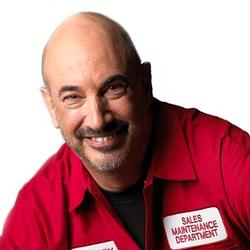Revenue Center Management has been the pivotal dealer Best Practice for over thirty years. Yet, why are so many dealers floundering in specific business areas? I think it concerns Bus Drivers, Controls, Maps, and Tools.
It takes a Bus Driver (Revenue Center Manager) to get you where you want to go in each Revenue Center. This implies that each Revenue Center must have a Bus Driver to be profitable and optimize performance. This should include Parts, Service, Rentals, Used Machinery, and New Machinery.
Bus drivers are the department managers who must organize their resources and make it happen. Yet, even if appointed and given the responsibility, many seem lost and out of control. They are uncertain about how to fix problems and overcome obstacles along the way. Here are the top reasons why:
1. Inadequate Quantitative Performance Objectives
Critical Profit Variables (CPVs) exist for each machinery dealer Revenue Center. These are a small number of essential metrics your Bus Drivers must establish, measure, monitor, and control. How they utilize this information for their Revenue Center determines if they become more profitable and achieve long-term objectives.
Your current score on these long-term performance targets establishes your current position. Our next article will examine these few performance metrics that generate improved profitability and achieve long-term objectives.
2. Unawareness Of Best Practices in Each Revenue Center
Best Practices are the qualitative policies, processes, and procedures best-in-class dealers employ to foster profitable growth and customers and produce harmony and discipline in the dealership. Selecting from the 450 Best Practices, we examined several for each Revenue Center. For example, dealers who foster and maintain strong “team play” gain a lasting and significant competitive advantage. This was clearly demonstrated by several Volvo heavy-duty truck dealers I visited.
3. Inadequate Dealer Information Systems
Technology is the great equalizer for the smaller dealer. The cost of a comprehensive management information system has dropped dramatically. And it is virtually impossible to be competitive today without a highly functional system.
Computerized management information systems have improved exponentially in terms of performance and costs since I sold them to Burroughs in the late 1960s. We are now in the digital age.
A digital dealership business moves beyond the traditional core systems, such as computerized accounting and financial reporting. A major emphasis now is on real-time and continuous customer engagement. Digital is used to improve customer relationships and connect with potential and previous buyers.
This will be especially important for manufacturers. We recommend they endorse a specific information systems vendor for their dealer organization. OEMs should work toward developing standard formats and useful dashboard analytics to highlight and leverage the dealers’ treasure trove of hidden customer transaction data. In an upcoming article, we will examine how to structure an information technology strategy.
4. Poorly Used Dashboard Summary Controls
Dealer Principals, as well as Bus Drivers, need a “Daily Flash Report.” We need to be able to make adjustments to our game performance before the end of the day. If you are experiencing a significant problem, you need to be able to spot it and fix it with the right tools. Waiting for the end of- monthly financials is far too late. The inning or first half is over. And we’re still thinking about “who’s on first” or “why did we get that penalty.” A good example is a drop in labor productivity that happened yesterday. Why? What caused it? Are you sure? How can you fix it NOW before the game is lost today? We will review a highly useful flash report.
5. Bus Drivers May Have Difficulty Determining the Route
There are so many distractions and interruptions. What are the key performance leverage points? What are the Critical Profit Variables for the Revenue Center? Which will really get you where you want and need to go? How do you focus on the most critical issues impacting your business? How do you determine the financial value of alternate management actions? Where should we invest our scarce and costly resources: time, budget, knowledge, and skills? How do you set proper milestones and track your progress to ensure you are on the right track? How can you reduce the chaos and fire-fighting? I’ll show you.
6. Bus Drivers May Lack the Skillful Use of Tools
One of the fundamental distinguishing features of the human species is our ability to make and use tools. The appearance of stone tools began about 3.3 million years ago and marks the critical first step in human cultural development. Tools enabled early hominids living near Lake Turkana in Kenya to widen the range of food available to them. Then, about 1.5 million years ago, significant improvements in stone implement technology yielded such marvels as sharply pointed hand axes and cleavers.
A very sharp instrument could be made by working both sides of a lava flake. These new tools enabled early humans to move from scavenging to active hunting, providing defensive and offensive weapons against predators and enemies. Then, about 120,000 years ago, many aspects of human behavior existed, including hunting and gathering as a successful way of life, using fire, and simple but effective technology in stone and wood tools. Our earliest ancestors skillfully employed tools and managed to acquire food, make clothing, and find shelter essential to their survival.
The modern dealer business is similar in many ways. The skillful use of management tools enables an equipment dealership to survive and prosper, outwit predatory competition, and achieve financial objectives. The management tools, Critical Profit Variables (CPVs), discussed in these articles are not complicated but often require training for skillful deployment and application.
Your employees may be your greatest asset, but they must be trained in the proficient use of tools, or your survival in a very hostile environment could be at risk.
Dealers can examine bus driver performance in its entirety through their ability to provide management and leadership in the proper application of these tools. Therefore, you must keep your management training current and ongoing.
Welcome aboard. See you next time.
About the Author:
The McDonald Group helps our clients identify their crucial performance issues and work with them to determine if there is an appropriate training solution. A unique capability of The McDonald Group, Inc. is our ability to structure training effectiveness measurements within the curriculum design to help ensure clients optimize the return on their training investment. We offer our flagship workshop, The Master’s Program in Dealer Management, to assist your leadership team in formally assessing your current sales and operations in each Revenue Center. Then, we build a powerful and realistic 2025 strategy to improve profitability, market share, cash flow, customer service, and retention.











